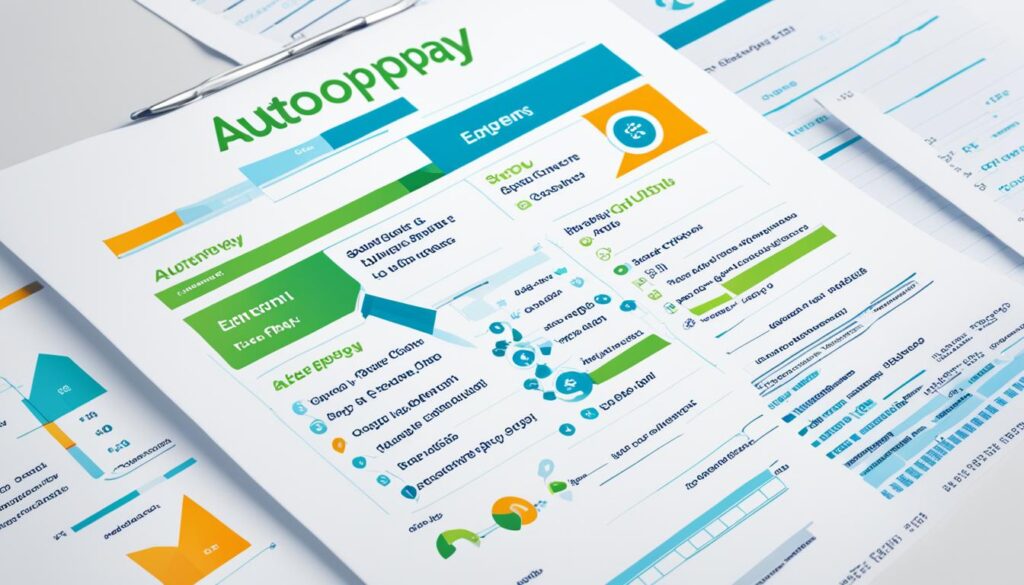“As an Amazon Associate I earn from qualifying purchases.”
Starting your journey to cut down on total loan costs may seem tough. But with the right advice, you can find your way more smoothly. It’s all about knowing the tricks to lower those costs, like understanding interest rates or making extra payments. These steps are key to improving your financial health.
Key Takeaways
- Understanding interest rates’ impact is foundational in managing overall loan costs.
- Implementing autopay can reduce interest rates for some loans.
- Extra payments can lead to significant interest savings over time1.
- Refinancing could be a fruitful strategy to achieve a lower interest rate and shorter loan term1.
- Credit monitoring through platforms like Experian helps in getting better loan terms1.
Learning about these strategies not only helps lessen the financial strain. It also gives you the power to make smarter choices for a firmer financial tomorrow.
Understanding How Interest Affects Your Loan Cost
Knowing how loan interest rates change your loan’s cost is key in handling your money. These rates shape your monthly payments and the total amount you’ll end up paying. A loan’s interest can make or break your budget over time2.
Assessing the Impact of Interest Rates on Total Loan Cost
Interest rates greatly affect how much interest you’ll pay on loans or credit cards2. A small change in rates can make a big difference in the long run. Fixed rates keep your payments the same, while variable rates can change suddenly2.
This shows why knowing your APR—the total yearly cost to borrow—is vital2.
The Benefits of Making Payments During Grace Periods
Grace periods let you skip payments for a while, without penalties. Paying during this time, especially on loans with compound interest, cuts down on interest. It also decreases the principal quicker. This means you’ll pay less interest over the life of the loan.
Strategies for Paying Off Interest before Principal to Minimize Costs
Paying off interest before touching the principal can save you money. This is especially true for high-rate loans2. Lowering interest before it increases the principal lowers the total loan cost. It helps clear the principal faster, reducing interest over time and making repayment easier.
Grasping these elements is key for your financial health. Using simple strategies, like reviewing interest rates’ effects and prioritizing payments, helps you make smarter financial choices.
Autopay Enrollment Benefits: Lower Rates and Simplified Budgeting

Autopay makes managing your loans each month easier and offers real finance benefits. By setting up autopay, many lenders will lower your interest rates. This can save you a lot of money over time.
PNC Bank gives a 0.50% interest rate cut to those who use autopay3. For student loans, autopay could lower your rates by up to 0.25 percentage points3. These small reductions add up, saving you a significant amount on your loans.
Let’s look at a $20,000 student loan at a 5% interest rate. By reducing your rate by 0.25% through autopay, you save about $293 over ten years3. The savings grow when applied to larger or multiple loans, showing the power of simple budgeting.
- Autopay helps you make payments on time, avoiding late fees. Late payments can hurt your FICO score a lot3.
- Look into refinancing if interest rates drop after you get your loan. This maximizes your savings from lower rates3.
Autopay isn’t just about saving money; it’s also convenient and keeps your finances on track. Once you set it up, your payments are made automatically. This means you won’t miss payments and hurt your credit score.
In the end, autopay has many benefits, from saving you money to helping you manage your budget better. By choosing autopay, you’re making a smart financial decision. It helps keep your credit score safe and lowers what you pay in interest. Autopay is a key tool for smart financial management, no matter what kind of loans you have.
How Can You Reduce Your Total Loan Cost? | Extra Payments and Loan Terms
Smart choices about your loan payments can lessen your financial load. Learn how higher payments and smart loan term choices can save you money in the long run.
Effects of Paying More Than the Minimum Required
Paying above the minimum on loans cuts down the principal quicker and slashes the total interest. Upping your monthly payments can shorten the loan length, which saves money over time. Adding just an extra payment yearly by rounding up can fast-forward your payoff schedule4.
How Additional Payments Shorten Loan Terms and Total Interest
Extra payments towards your loan cut both the term and interest. Use unexpected money like tax returns or bonuses on the loan principal. This move can shorten the loan’s life and reduce interest over time4. Moreover, making bi-weekly payments helps by adding one extra payment yearly without stressing your budget4.
Allocating Extra Payments to Higher Interest Loans to Save More
Focus extra payments on high-interest loans to save more. This tactic tackles the priciest debts first, cutting overall interest costs. It simplifies paying off several loans and amplifies the impact of every extra dollar paid1.
Knowing how loan terms affect your money is crucial. Short loan terms mean higher monthly payments but less interest, lowering borrowing costs. But, longer terms, despite smaller monthly payments, rack up more interest over the loan’s life15.
| Strategy | Benefit | Example |
|---|---|---|
| Bi-weekly Payments | Shorten loan term | Making bi-weekly payments of $150 instead of $300 monthly4 |
| Rounding Payments | Extra payment annually | Rounding up to the nearest $50 monthly payment4 |
| Extra Payments to High-Interest Loans | Saves more in long term | Allocating bonuses to high-interest rate loans1 |
Adding these tactics to your finance plan can vastly reduce loan stress. By adopting strategies like extra payments and adjusting loan terms, you’re on track to better financial health and quicker debt freedom.
Exploring Loan Consolidation and Refinancing Opportunities

If you’re aiming to reduce your loan costs, understanding loan consolidation and loan refinancing is key. These strategies can manage multiple loans. They can also cut down your payments and overall interest rates.
Loan consolidation combines your loans into one. This could stretch your repayment from 10 years to 20 or 30 years. You might enjoy lower monthly payments. Yet, it could raise the total interest across the loan’s life678. A Direct Consolidation Loan uses a weighted average of your loans’ rates, slightly upping your rate6.
- Consolidation might turn unpaid interest into a bigger principal balance, raising the overall cost6.
- Refinancing with private entities could offer better rates than you currently have, possibly lowering your monthly expenses8.
- But, switching federal loans to a private lender loses federal benefits. These include possible loan forgiveness and tailored repayment plans8.
Think over if the perks of single payments and lower rates beat the longer payment period and potential benefit losses6. Also, refinancing usually needs a credit check and a good credit score78. This is not needed for a federal consolidation loan8.
| Strategy | Benefits | Considerations |
|---|---|---|
| Loan Consolidation | Single monthly payment, potential lower payments | Extended repayment period, loss of some loan-specific benefits |
| Loan Refinancing | Possibly lower interest rates, reduced monthly payments | Requires credit check, forfeits federal loan benefits |
By carefully assessing loan consolidation and refinancing opportunities, you can shape your financial strategy to fit your long-term money goals. Always consider the pros and cons for your particular financial situation to make the best choice.
Conclusion
To sum up our discussion on cutting loan costs, there are many paths to lighten the loan load. Tips like knowing how interest works, using autopay for discounts, and smart payment choices can cut down what you owe. One tip is paying every two weeks, which can save you about $300 more yearly than paying monthly4.
Also, think about debt restructuring through consolidation or refinancing for better interest rates and lower payments. A simple action like increasing your payments to the next $50 can add one extra payment each year. This way, you save without your wallet feeling it4.
Don’t forget to look into scholarships and grants. Unlike loans, you don’t have to pay these back, making them a smarter option for funding education4. For deeper insights and more tips on managing student loans effectively, check out Ways to Reduce Your Total Student Loan Cost. With the right information, you can take charge of your loans, save money, and ensure a stable financial future.
FAQ
How can I reduce the total cost of my loan?
How do interest rates affect the total cost of my loan?
What are the benefits of making payments during grace periods?
What strategies can I use to pay off interest before principal and minimize costs?
How does enrolling in autopay benefit me in reducing my loan cost?
How do extra payments on my loan help to reduce the total cost?
What are the benefits of loan consolidation and refinancing in reducing my total loan cost?
Source Links
- https://www.experian.com/blogs/ask-experian/how-to-reduce-your-total-loan-cost/
- https://www.equifax.com/personal/education/personal-finance/articles/-/learn/what-do-interest-rates-mean/
- https://www.experian.com/blogs/ask-experian/how-can-student-loan-autopay-save-you-money/
- https://stibermanlaw.com/ways-to-reduce-total-student-loan-cost/
- https://www.achieve.com/learn/personal-loans/how-can-you-reduce-your-total-loan-cost
- https://studentaid.gov/articles/5-things-before-consolidating-student-loans/
- https://www.nerdwallet.com/article/loans/student-loans/consolidate-student-loans
- https://www.discover.com/student-loans/repayment/finance/student-loan-consolidation
“As an Amazon Associate I earn from qualifying purchases.”

